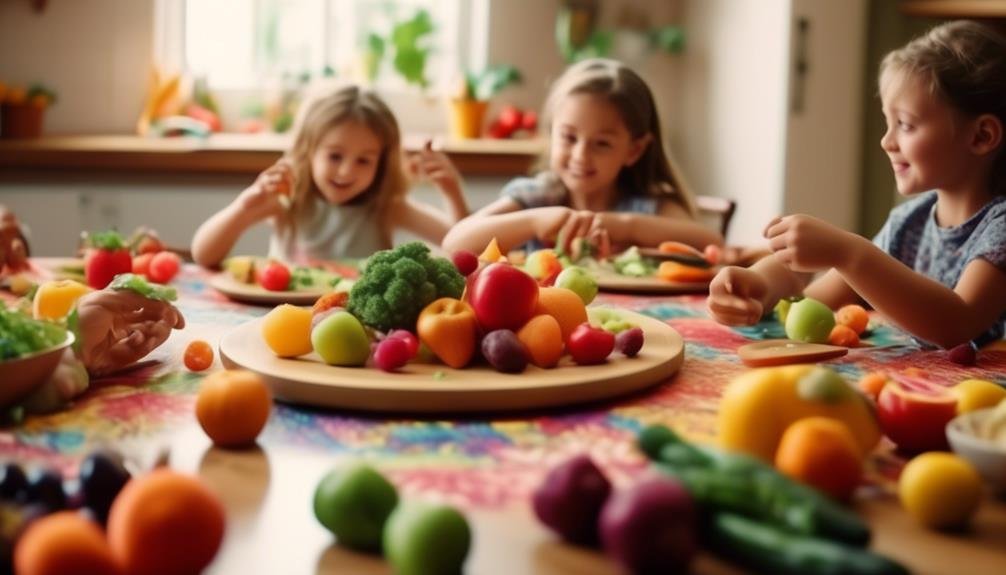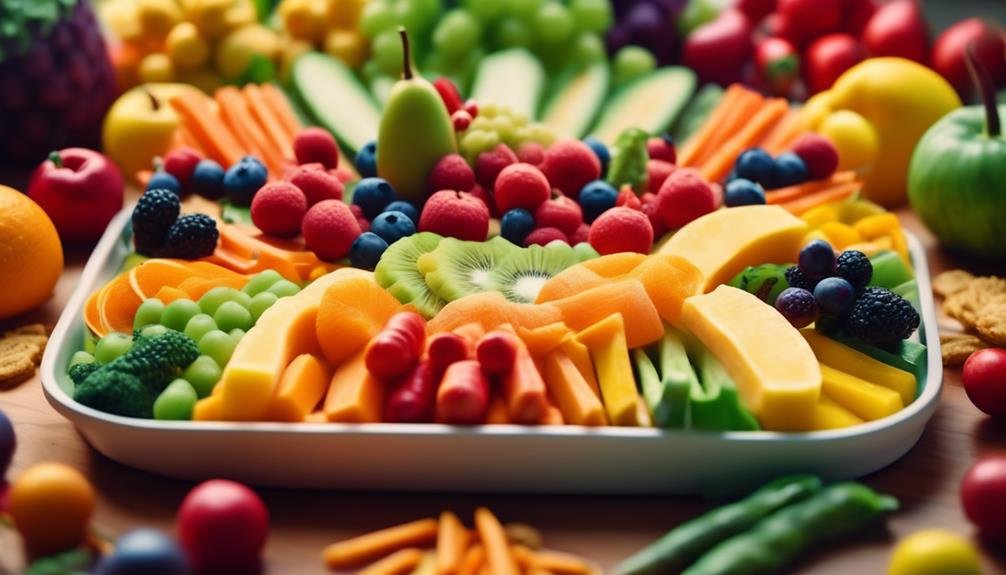"Cherishing Little Steps - A Haven for Baby and Family Journeys"
Educating Kids About Food
Are your kids clueless when it comes to the wonderful world of food? It's time to help them take a bite out of knowledge and savor the benefits of a healthy diet.
But where do you begin? Well, imagine opening a treasure chest of culinary wonders, filled with vibrant flavors, fascinating food groups, and the secrets behind every delicious dish.
In this discussion, we will embark on a journey to educate your little ones about the joys of food, exploring its origins, uncovering its mysteries, and instilling a lifelong love for all things delicious.
So, are you ready to embark on this flavorful adventure?
Key Takeaways
- Healthy eating is essential for maintaining optimal physical and mental well-being.
- Teaching children about different food groups and the importance of a balanced diet empowers them to make choices that promote long-term health.
- Understanding where food comes from fosters a deeper appreciation for it and encourages children to choose locally sourced and seasonal produce.
- Engaging children in hands-on cooking activities and making mealtime a learning experience helps them develop essential culinary skills, decision-making skills, and a greater understanding of food and nutrition.
The Importance of Healthy Eating

Eating healthily is vital for maintaining optimal physical and mental well-being throughout your life. When it comes to teaching nutrition to children, it's important to instill healthy eating habits early on. By doing so, you're setting them up for a lifetime of good health and well-being.
One of the key reasons why teaching nutrition to children is crucial is because it helps to establish a strong foundation for their overall development. Proper nutrition provides the necessary nutrients that support growth, brain function, and immune system function. By teaching children about the importance of healthy eating, you're equipping them with the knowledge and skills to make informed choices about the foods they consume.
Furthermore, teaching nutrition to children can help prevent various health issues later in life. Research has shown that a balanced diet, rich in fruits, vegetables, whole grains, and lean proteins, can reduce the risk of chronic diseases such as obesity, heart disease, and type 2 diabetes. By educating children about the benefits of healthy eating, you're empowering them to make choices that promote long-term health and well-being.
Exploring Different Food Groups
To develop a well-rounded understanding of nutrition, it is essential to explore the different food groups and the unique benefits they offer for your overall health and well-being. A balanced diet consists of foods from each of the five major food groups: fruits, vegetables, grains, protein, and dairy. By incorporating a variety of foods from these groups into your daily meals, you can ensure that you are getting all the necessary nutrients your body needs.
To help you visualize the different food groups and their recommended servings, here is a simple breakdown:
| Food Group | Recommended Servings |
|---|---|
| Fruits | 2 cups |
| Vegetables | 2.5 cups |
| Grains | 6 ounces |
| Protein | 5.5 ounces |
| Dairy | 3 cups |
The food pyramid is a useful tool that can guide you in making healthy food choices. It emphasizes the importance of consuming a variety of nutrient-dense foods from all the different food groups. Remember, a balanced diet not only provides you with energy but also supports proper growth, development, and overall well-being.
Teaching Where Food Comes From

Understanding where our food comes from is an important aspect of educating kids about nutrition and fostering a deeper appreciation for the food they eat. By teaching children about agricultural practices and the sustainability of food sources, we can empower them to make informed choices and develop a lifelong connection with the food they consume.
When it comes to agricultural practices, kids should be aware of how their food is grown and produced. They need to understand the impact of conventional farming methods, such as the use of pesticides and synthetic fertilizers, on the environment and their health. Introducing them to organic farming practices, which prioritize soil health, biodiversity, and natural pest control, can help them appreciate the importance of sustainable farming.
Moreover, teaching kids about the sustainability of food sources is crucial in today's world. They need to know how our food choices impact the planet, including climate change, deforestation, and water scarcity. By discussing the concept of food miles and the environmental footprint of different foods, we can encourage them to choose locally sourced and seasonal produce.
Engaging in Hands-On Cooking Activities
Get ready to roll up your sleeves and dive into the world of hands-on cooking activities with your kids! Engaging in hands-on cooking activities isn't only a fun way to spend time together, but it also provides numerous benefits for your child's development.
Hands-on learning has been proven to be highly effective in helping children grasp and retain information. When children actively participate in the cooking process, they're more likely to remember the ingredients, techniques, and flavors they encounter. This hands-on approach also promotes sensory exploration, as your child gets to touch, smell, and taste different ingredients.
Additionally, engaging in culinary activities helps develop essential culinary skills. By involving your child in meal preparation, they learn basic cooking techniques such as measuring ingredients, mixing, and chopping. These skills not only contribute to their independence in the kitchen but also lay the foundation for a lifetime of healthy eating habits.
Furthermore, hands-on cooking activities provide an opportunity for your child to develop a sense of responsibility and teamwork. Assigning age-appropriate tasks, such as setting the table or washing vegetables, allows them to contribute to the meal preparation process and feel a sense of accomplishment. It also encourages cooperation and communication between family members, fostering a positive and supportive environment.
Making Mealtime a Learning Experience

Now that you have engaged your child in hands-on cooking activities, it's time to take their learning experience to the next level by making mealtime a valuable opportunity for education. Interactive mealtime can be a fun and effective way to teach your child about food and nutrition. Here are four ideas to make mealtime a learning experience:
- Discuss the different food groups: Take a few minutes before each meal to talk about the nutritional benefits of the food you're about to eat. Explain why it's important to have a balanced diet and the role each food group plays in keeping our bodies healthy.
- Encourage your child to choose their own meal: Give your child a chance to make decisions about what they want to eat. Provide them with a variety of healthy options and let them pick what they'd like to have. This not only helps them develop decision-making skills but also empowers them to take ownership of their food choices.
- Involve your child in meal planning: Ask your child to help you plan the meals for the week. Let them suggest new recipes or ingredients they'd like to try. This not only sparks their creativity but also teaches them about meal planning, budgeting, and grocery shopping.
- Make mealtime a family affair: Use mealtime as a time to connect and bond as a family. Encourage everyone to share their day, ask questions, and have meaningful conversations. This creates a positive and nurturing environment that makes mealtime an enjoyable and educational experience.
Introducing New and Exciting Flavors
Introduce your child to a world of new and exciting flavors by incorporating a variety of herbs, spices, and ingredients into their meals. By doing so, you can create new taste sensations and embark on culinary adventures together.
One way to introduce new flavors is by using herbs and spices. Herbs like basil, thyme, and cilantro can add freshness and depth to dishes, while spices like cumin, paprika, and turmeric can bring warmth and complexity. Start by adding small amounts of these herbs and spices to familiar dishes, gradually increasing the quantity as your child becomes more accustomed to the flavors.
Another way to explore new flavors is by trying different ingredients. For example, you can introduce your child to exotic fruits like dragon fruit, mango, or pomegranate to experience their unique flavors and textures. You can also experiment with different types of grains, such as quinoa or farro, to add variety to your meals.
Make the process of trying new flavors fun and interactive. Let your child help you choose the herbs, spices, and ingredients at the grocery store. Encourage them to smell and taste the different options, discussing the flavors together. This not only educates them about food but also empowers them to make their own choices.
Incorporating new and exciting flavors into your child's meals can open up a world of culinary possibilities. It encourages exploration, expands their palate, and cultivates a love for diverse foods. So, embark on this culinary adventure together and create unforgettable taste experiences for your child.
Encouraging Smart Snacking Habits

To foster healthy eating habits, it's important to guide your child towards smart snacking choices. Encouraging smart snacking habits can't only provide your child with the necessary energy throughout the day but also promote mindful eating and exploring portion control.
Here are four tips to help you inculcate smart snacking habits in your child:
- Offer a variety of nutritious snacks: Introduce your child to a wide range of healthy snacks such as fruits, vegetables, whole grain crackers, and yogurt. This won't only provide them with essential nutrients but also keep their taste buds satisfied.
- Make snacks easily accessible: Keep a bowl of washed and cut fruits on the kitchen counter or have pre-portioned snacks readily available in the refrigerator. By making healthy options easily accessible, you can encourage your child to choose them over less nutritious alternatives.
- Involve your child in snack preparation: Engage your child in preparing their snacks. This won't only teach them about portion sizes but also make them more excited about eating healthy snacks they've helped create.
- Encourage mindful eating: Teach your child to eat slowly and savor each bite. By encouraging them to pay attention to their hunger and fullness cues, they'll be less likely to overeat and more likely to develop a healthy relationship with food.
Understanding Food Labels and Ingredients
Understanding food labels and ingredients is essential for making informed choices about the food you and your child consume. Reading nutrition facts and decoding ingredient lists can help you understand the nutritional content and potential health impacts of the foods you buy.
When reading nutrition facts, pay attention to serving sizes and the amounts of key nutrients, such as calories, fat, sodium, and sugar. Compare these values to your dietary needs and consider the overall balance of nutrients. Look for foods that are lower in saturated fat, trans fat, and added sugars, while higher in fiber, vitamins, and minerals.
Decoding ingredient lists can be a bit more challenging, but it's worth the effort. Ingredients are listed in descending order of weight, so the first few ingredients make up the bulk of the product. Be aware of ingredients such as high-fructose corn syrup, artificial sweeteners, and hydrogenated oils, which can have negative impacts on health. Additionally, watch out for hidden sources of added sugars and unhealthy fats. Familiarize yourself with different names for sugar and unhealthy fats, such as dextrose, fructose, and partially hydrogenated oils.
Instilling a Lifelong Love for Food

Encouraging a lifelong love for food starts with exposing children to a wide variety of flavors, textures, and cuisines from an early age. By teaching culinary skills and fostering an appreciation for global cuisine, you can cultivate a deep and lasting connection to food that will benefit your child throughout their life.
Here are four ways to instill a lifelong love for food in your little ones:
- Get them involved in the kitchen: Encourage your children to participate in meal preparation by giving them age-appropriate tasks. Let them chop vegetables, mix ingredients, and even plan a menu. This hands-on experience won't only teach them valuable culinary skills but also make them more excited about food.
- Explore different cuisines: Introduce your child to the diverse world of global cuisine. Take them to restaurants that serve food from different countries, or prepare meals from various cultural traditions at home. Exposing your child to new flavors and cuisines will broaden their palate and expand their appreciation for different types of food.
- Grow a garden: Planting a small garden or even just a few herbs in pots can be a fun and educational activity for children. They'll learn about where food comes from, how it grows, and the joy of harvesting and cooking with fresh ingredients.
- Make mealtime an enjoyable experience: Create a positive and relaxed atmosphere during mealtimes. Sit down together as a family, engage in conversation, and savor the flavors of each dish. By making mealtime a pleasant and social experience, you're reinforcing the idea that food isn't just fuel, but a source of pleasure and connection.
Frequently Asked Questions
How Can I Teach My Child to Make Healthy Food Choices When Dining Out?
When dining out, teach your child to make healthy food choices by encouraging them to opt for grilled or baked dishes, choose water instead of sugary drinks, and include fruits and vegetables in their meals.
What Are Some Fun and Interactive Ways to Teach Kids About the Importance of Portion Control?
"Teaching your child about portion control can be fun and interactive. Try playing games that involve sorting food into different portion sizes or using visual aids like measuring cups. Keep it engaging and educational!"
How Can Parents Encourage Their Children to Eat a Variety of Fruits and Vegetables?
To encourage adventurous eating and get your kids excited about fruits and veggies, try creative recipes like fruit skewers or veggie-packed smoothies. Show them that healthy food can be fun and delicious!
What Are Some Effective Strategies for Dealing With Picky Eaters and Getting Them to Try New Foods?
To deal with picky eaters and encourage them to try new foods, involve them in meal prep and introduce new foods through familiar dishes. It helps create a sense of familiarity and curiosity, making them more likely to give new foods a chance.
How Can Parents Address the Issue of Food Allergies and Intolerances When Educating Their Children About Food?
To address food allergies and intolerances when educating your children about food, start by understanding their specific needs. Use strategies like reading food labels, teaching them to communicate their needs, and providing resources for support.
Conclusion
In conclusion, educating kids about food is crucial for their overall health and well-being. By teaching them about the importance of healthy eating, exploring different food groups, and engaging in hands-on cooking activities, we can instill a lifelong love for food and empower them to make smart choices.
Just like a garden, where every plant needs the right nutrients to grow strong and vibrant, our children need a well-balanced diet to thrive and reach their full potential.
Let's sow the seeds of knowledge and watch them blossom into healthy eaters.



Can you be more specific about the content of your article? After reading it, I still have some doubts. Hope you can help me.
Can you be more specific about the content of your article? After reading it, I still have some doubts. Hope you can help me.
You really make it appear so easy along with your
presentation however I find this matter to be really something which I
feel I would by no means understand. It kind of feels too complex and very wide for me.
I’m having a look ahead to your subsequent publish, I’ll try to get
the hang of it! Lista escape roomów
Hello to every one, as I am actually keen of reading this web
site’s post to be updated on a regular basis.
It contains good data.
This website definitely has all of the info I wanted concerning this subject and didn’t know who to ask.
That is a good tip especially to those fresh to the blogosphere. Brief but very accurate information… Thanks for sharing this one. A must read post.
I must thank you for the efforts you have put in writing this blog. I’m hoping to see the same high-grade blog posts from you in the future as well. In fact, your creative writing abilities has motivated me to get my own, personal blog now 😉
Very nice blog post. I definitely appreciate this site. Stick with it!